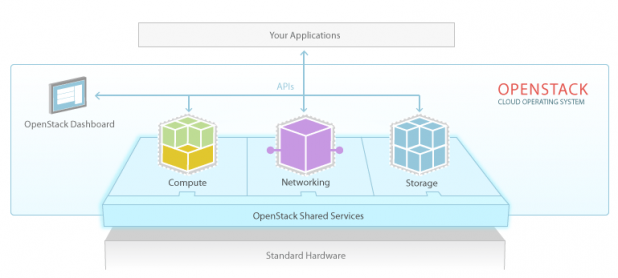 The OpenStack project centers on an open-source cloud-operating system.[/caption] Two years after the OpenStack project came into being, the OpenStack Foundation has officially launched. One of its first moves: hiring Alan Clark, director of industry initiatives and open source at SUSE, as chairman of the board. The foundation has already lined up more than 5,600 individual members and secured more than $10 million in funding. The goal of the project is simple: create open-source software for building public and private clouds. It includes OpenStack Storage, described as a “fully distributed, API-accessible storage platform that can be integrated directly applications or used for backup, archiving and data retention,” as well as OpenStack Compute, designed to scale the software on standard hardware. The foundation will take the project step further by pushing the development and distribution of that cloud operating system. Rackspace and NASA launched the OpenStack project in July 2010, supported by around 25 countries and a selection of independent developers. Those numbers have subsequently grown to more than 180 participating companies and 550 contributing developers, in addition to six software releases in a little over two years. (Members are expected to contribute through either technical contributions or community building.) In 2011, Rackspace announced that it would be transitioning management of OpenStack to an independent foundation structure, allowing it to further develop without corporate oversight. "Since its inception, we knew a foundation was the ultimate goal for OpenStack,” Lew Moorman, president of Rackspace, wrote in a statement. “Today, we are proud to finalize the process by donating the assets, handing over community management and giving the OpenStack trademark to the OpenStack Foundation.” The launch is a defining moment for the open cloud movement, added Jonathan Bryce, executive director of the OpenStack Foundation, in a statement. "When you look at what this community has done to innovate and make cloud technologies accessible, as well as make open source synonymous with cloud computing, you understand why huge technology industry leaders and users across the world are placing their bets on OpenStack.”
The OpenStack project centers on an open-source cloud-operating system.[/caption] Two years after the OpenStack project came into being, the OpenStack Foundation has officially launched. One of its first moves: hiring Alan Clark, director of industry initiatives and open source at SUSE, as chairman of the board. The foundation has already lined up more than 5,600 individual members and secured more than $10 million in funding. The goal of the project is simple: create open-source software for building public and private clouds. It includes OpenStack Storage, described as a “fully distributed, API-accessible storage platform that can be integrated directly applications or used for backup, archiving and data retention,” as well as OpenStack Compute, designed to scale the software on standard hardware. The foundation will take the project step further by pushing the development and distribution of that cloud operating system. Rackspace and NASA launched the OpenStack project in July 2010, supported by around 25 countries and a selection of independent developers. Those numbers have subsequently grown to more than 180 participating companies and 550 contributing developers, in addition to six software releases in a little over two years. (Members are expected to contribute through either technical contributions or community building.) In 2011, Rackspace announced that it would be transitioning management of OpenStack to an independent foundation structure, allowing it to further develop without corporate oversight. "Since its inception, we knew a foundation was the ultimate goal for OpenStack,” Lew Moorman, president of Rackspace, wrote in a statement. “Today, we are proud to finalize the process by donating the assets, handing over community management and giving the OpenStack trademark to the OpenStack Foundation.” The launch is a defining moment for the open cloud movement, added Jonathan Bryce, executive director of the OpenStack Foundation, in a statement. "When you look at what this community has done to innovate and make cloud technologies accessible, as well as make open source synonymous with cloud computing, you understand why huge technology industry leaders and users across the world are placing their bets on OpenStack.”
Nebula Lures Key OpenStack Engineers
[caption id="attachment_4667" align="aligncenter" width="618"]  The OpenStack project centers on an open-source cloud-operating system.[/caption] Two years after the OpenStack project came into being, the OpenStack Foundation has officially launched. One of its first moves: hiring Alan Clark, director of industry initiatives and open source at SUSE, as chairman of the board. The foundation has already lined up more than 5,600 individual members and secured more than $10 million in funding. The goal of the project is simple: create open-source software for building public and private clouds. It includes OpenStack Storage, described as a “fully distributed, API-accessible storage platform that can be integrated directly applications or used for backup, archiving and data retention,” as well as OpenStack Compute, designed to scale the software on standard hardware. The foundation will take the project step further by pushing the development and distribution of that cloud operating system. Rackspace and NASA launched the OpenStack project in July 2010, supported by around 25 countries and a selection of independent developers. Those numbers have subsequently grown to more than 180 participating companies and 550 contributing developers, in addition to six software releases in a little over two years. (Members are expected to contribute through either technical contributions or community building.) In 2011, Rackspace announced that it would be transitioning management of OpenStack to an independent foundation structure, allowing it to further develop without corporate oversight. "Since its inception, we knew a foundation was the ultimate goal for OpenStack,” Lew Moorman, president of Rackspace, wrote in a statement. “Today, we are proud to finalize the process by donating the assets, handing over community management and giving the OpenStack trademark to the OpenStack Foundation.” The launch is a defining moment for the open cloud movement, added Jonathan Bryce, executive director of the OpenStack Foundation, in a statement. "When you look at what this community has done to innovate and make cloud technologies accessible, as well as make open source synonymous with cloud computing, you understand why huge technology industry leaders and users across the world are placing their bets on OpenStack.”
The OpenStack project centers on an open-source cloud-operating system.[/caption] Two years after the OpenStack project came into being, the OpenStack Foundation has officially launched. One of its first moves: hiring Alan Clark, director of industry initiatives and open source at SUSE, as chairman of the board. The foundation has already lined up more than 5,600 individual members and secured more than $10 million in funding. The goal of the project is simple: create open-source software for building public and private clouds. It includes OpenStack Storage, described as a “fully distributed, API-accessible storage platform that can be integrated directly applications or used for backup, archiving and data retention,” as well as OpenStack Compute, designed to scale the software on standard hardware. The foundation will take the project step further by pushing the development and distribution of that cloud operating system. Rackspace and NASA launched the OpenStack project in July 2010, supported by around 25 countries and a selection of independent developers. Those numbers have subsequently grown to more than 180 participating companies and 550 contributing developers, in addition to six software releases in a little over two years. (Members are expected to contribute through either technical contributions or community building.) In 2011, Rackspace announced that it would be transitioning management of OpenStack to an independent foundation structure, allowing it to further develop without corporate oversight. "Since its inception, we knew a foundation was the ultimate goal for OpenStack,” Lew Moorman, president of Rackspace, wrote in a statement. “Today, we are proud to finalize the process by donating the assets, handing over community management and giving the OpenStack trademark to the OpenStack Foundation.” The launch is a defining moment for the open cloud movement, added Jonathan Bryce, executive director of the OpenStack Foundation, in a statement. "When you look at what this community has done to innovate and make cloud technologies accessible, as well as make open source synonymous with cloud computing, you understand why huge technology industry leaders and users across the world are placing their bets on OpenStack.”
 The OpenStack project centers on an open-source cloud-operating system.[/caption] Two years after the OpenStack project came into being, the OpenStack Foundation has officially launched. One of its first moves: hiring Alan Clark, director of industry initiatives and open source at SUSE, as chairman of the board. The foundation has already lined up more than 5,600 individual members and secured more than $10 million in funding. The goal of the project is simple: create open-source software for building public and private clouds. It includes OpenStack Storage, described as a “fully distributed, API-accessible storage platform that can be integrated directly applications or used for backup, archiving and data retention,” as well as OpenStack Compute, designed to scale the software on standard hardware. The foundation will take the project step further by pushing the development and distribution of that cloud operating system. Rackspace and NASA launched the OpenStack project in July 2010, supported by around 25 countries and a selection of independent developers. Those numbers have subsequently grown to more than 180 participating companies and 550 contributing developers, in addition to six software releases in a little over two years. (Members are expected to contribute through either technical contributions or community building.) In 2011, Rackspace announced that it would be transitioning management of OpenStack to an independent foundation structure, allowing it to further develop without corporate oversight. "Since its inception, we knew a foundation was the ultimate goal for OpenStack,” Lew Moorman, president of Rackspace, wrote in a statement. “Today, we are proud to finalize the process by donating the assets, handing over community management and giving the OpenStack trademark to the OpenStack Foundation.” The launch is a defining moment for the open cloud movement, added Jonathan Bryce, executive director of the OpenStack Foundation, in a statement. "When you look at what this community has done to innovate and make cloud technologies accessible, as well as make open source synonymous with cloud computing, you understand why huge technology industry leaders and users across the world are placing their bets on OpenStack.”
The OpenStack project centers on an open-source cloud-operating system.[/caption] Two years after the OpenStack project came into being, the OpenStack Foundation has officially launched. One of its first moves: hiring Alan Clark, director of industry initiatives and open source at SUSE, as chairman of the board. The foundation has already lined up more than 5,600 individual members and secured more than $10 million in funding. The goal of the project is simple: create open-source software for building public and private clouds. It includes OpenStack Storage, described as a “fully distributed, API-accessible storage platform that can be integrated directly applications or used for backup, archiving and data retention,” as well as OpenStack Compute, designed to scale the software on standard hardware. The foundation will take the project step further by pushing the development and distribution of that cloud operating system. Rackspace and NASA launched the OpenStack project in July 2010, supported by around 25 countries and a selection of independent developers. Those numbers have subsequently grown to more than 180 participating companies and 550 contributing developers, in addition to six software releases in a little over two years. (Members are expected to contribute through either technical contributions or community building.) In 2011, Rackspace announced that it would be transitioning management of OpenStack to an independent foundation structure, allowing it to further develop without corporate oversight. "Since its inception, we knew a foundation was the ultimate goal for OpenStack,” Lew Moorman, president of Rackspace, wrote in a statement. “Today, we are proud to finalize the process by donating the assets, handing over community management and giving the OpenStack trademark to the OpenStack Foundation.” The launch is a defining moment for the open cloud movement, added Jonathan Bryce, executive director of the OpenStack Foundation, in a statement. "When you look at what this community has done to innovate and make cloud technologies accessible, as well as make open source synonymous with cloud computing, you understand why huge technology industry leaders and users across the world are placing their bets on OpenStack.”

